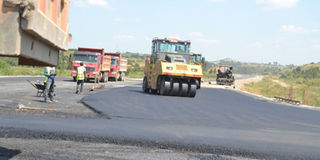Government set to tarmac more roads in Mbarara

Road construction works in Mbarara. During the second phase of USMID project, government will tarmac more roads within Mbarara Municipality. FILE PHOTO
Government will tarmac more roads in Mbarara Municipality under the second phase of the Uganda Support to Municipal Infrastructure Development Programme (USMID).
“We have now embarked on the second phase of this project where we are going to tarmac many more roads within Mbarara,” Mr Chris Baryomunsi, State Minister of Lands, Housing and Urban Development, said during the unveiling of Mbarara House – National Social Security Fund commercial building recently.
USMID is a $150m (Shs554b) five-year project (2013-2018) under the Ministry of Lands, Housing and Urban Development, funded by World Bank to develop infrastructure in municipalities.
The programme also aims at enhancing institutional performance of 14 Municipalities including Mbarara, Arua, Entebbe, Mbale, Soroti, Masaka, Gulu and Fort Portal among others, to improve urban service delivery.
While the first phase of the project saw its end last year, government says a second phase is in the offing with a bigger budget of $360m with 8 additional municipalities.
“The second phase, we are continuing with the 14 municipalities including Mbarara, we are going to add 8 more municipalities but this time round, the amount of money available is $360m(Shs1.3trillion),” he said.
Mbarara is among the nine municipalities that government elevated to city status in a bid to boost regional development. Others include: Fort Portal, Hoima, Lira, Arua, Gulu, Mbale, Jinja and Entebbe Municipality.
To ensure the cities are organised and beautiful, Mr Baryomunsi revealed that the ministry is hatching master plans in hopes of mitigating slums.
“We are now developing master physical plans for these new cities that have developed to arrest the slums which have already developed,” he said explaining that old settlements are turned into modern settlements.
New developments in these cities, he expounded, will have to be done in accordance with the approved physical plans for an organised country.
He, however, did not attach the expected cost of the reforms.
The minister also said government is looking to avoid a repeat situation such as that in Kampala where developments were not in accordance to the city’s physical plans.
Kampala
“We are now working on a programme to reengineer the Greater Metropolitan Kampala and put it back, making it a physically planned area,” he said noting that it is going to be expensive without revealing the cost.
Kampala City Council Authority in 2014 developed a five-year strategic plan seeking to rebuild institutional credibility and functionality while revamping basic urban infrastructure.
However, a report compiled by the Authority’s department of strategy management and business development in October 2018 revealed that only 12 per cent had been achieved four years later.
Addressing challenges
Previously, Dr Chris Baryomonsi, the state minister for Lands, Housing and Urban Development, said USMID Programme is responding to the development challenges associated with unprecedented urbanisation such as slums, poor sanitation, land degradation and poor infrastructure which Uganda is now facing.




